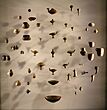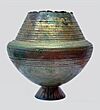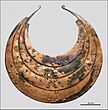Lusatian culture facts for kids
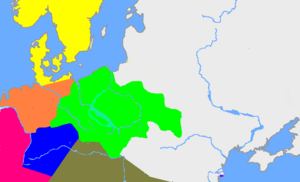
Lusatian culture's furthest extent (green)
|
|
| Alternative names | Lausitz culture |
|---|---|
| Geographical range | Central Europe |
| Period | Late Bronze Age to early Iron Age |
| Dates | c. 1200–500 BC |
| Preceded by | Trzciniec culture, Tumulus culture, Nordic Bronze Age, Urnfield culture |
| Followed by | Pomeranian culture, Cimmerians |
The Lusatian culture existed in the later Bronze Age and early Iron Age (1300–500 BC) in most of what is now Poland and parts of the Czech Republic, Slovakia, eastern Germany and western Ukraine. It covers the Periods Montelius III (early Lusatian culture) to V of the Northern European chronological scheme. It has been associated or closely linked with the Nordic Bronze Age. Hallstatt influences can also be seen particularly in ornaments (fibulae, pins) and weapons.
Origins
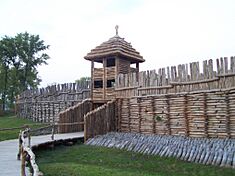
The Lusatian culture developed as the preceding Trzciniec culture experienced influences from the Tumulus culture of the Middle Bronze Age, essentially incorporating the local communities into the socio-political network of Iron Age Europe. It formed part of the Urnfield systems, origin of the Celts and Romans, found from eastern France, southern Germany and Austria to Hungary and the Nordic Bronze Age in northwestern Germany and Scandinavia. It was followed by the Billendorf culture of the Early Iron Age in the West. In Poland, the Lusatian culture is taken have spanned part of the Iron Age as well (there is only a terminological difference) and was succeeded in Montelius VIIbc in the northern ranges around the mouth of Vistula by the Pomeranian culture spreading south.
'Lusatian-type' burials were first described by the German pathologist and archaeologist Rudolf Virchow (1821–1902). The name refers to the Lusatia area in eastern Germany (Brandenburg and Saxony) and western Poland. Virchow identified the pottery artifacts as 'pre-Germanic' but refused to speculate on the ethnic identity of their makers. The Polish archeologist Józef Kostrzewski, who started in 1934 to conduct extensive excavations of a Lusatian settlement of Biskupin, hypothesised that the Lusatian culture was a predecessor of later cultures that belonged to the early Slavs. Modern archeologists, such as both K. Godłowski and P. Kaczanowski, hold the view that the ethnic geography of Bronze Age Central Europe then included peoples whose languages and ethnic identity are simply unknown.
Culture
Burial was by cremation; inhumations are rare. The urn is usually accompanied by numerous (up to 40) secondary vessels. Metal grave gifts are sparse, but there are numerous hoards (such as Kopaniewo, Pomerania) that contain rich metalwork, both bronze and gold (hoard of Eberswalde, Brandenburg). Graves containing moulds (like at Bataune, in Saxony) and tuyeres attest to the production of bronze tools and weapons at the village level. The 'royal' tomb of Seddin, Brandenburg, Germany, covered by a large earthen barrow, contained Mediterranean imports like bronze vessels and glass beads. Cemeteries can be quite large and contain thousands of graves.
Well-known settlements include Biskupin, in Poland, and Buch, near Berlin. There are both open villages and fortified settlements (burgwall or gord) on hilltops or in swampy areas. The ramparts were constructed of wooden boxes filled with soil or stones.
Its economy was mainly based on arable agriculture, as is attested by numerous storage pits. Wheat (emmer) and six-row barley formed the basic crops, together with millet, rye and oats, peas, broad beans, lentils, and gold of pleasure (Camelina sativa). Flax was grown, and remains of domesticated apples, pears, and plums have been found. Cattle and pigs were the most important domestic animals, followed by sheep, goats, horses, and dogs. Pictures on Iron Age urns from Silesia attest horse riding, but horses were used to draw chariots as well. Hunting was practiced, as bones of red and roe deer, boar, bison, elk, hare, fox, and wolf attest, but it did not provide much of the meat consumed. The numerous frog bones found at Biskupin may indicate that frogs' legs were eaten as well.
Gallery
-
Socketed axes and arm rings
-
Fibula and arm rings
-
Bronze arm rings, Germany
-
Bronze arm bands
-
Bronze tableware, 1200–1000 BC, Dresden, Germany
See also
- Lusatia
- Urnfield culture
- Nordic Bronze Age
- Hallstatt culture
- Schweinert burial mounds
- Heidenschanze fortified settlement









